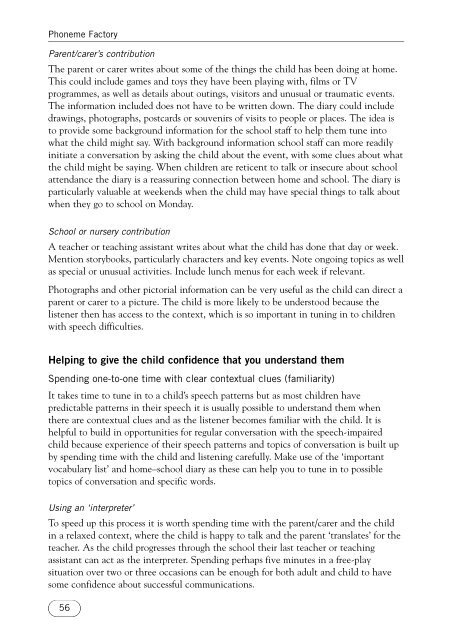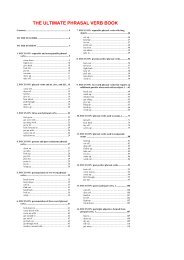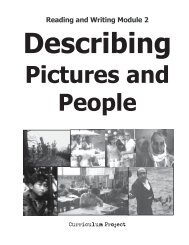Developing Speech and Language Skills - Noel's ESL eBook Library
Developing Speech and Language Skills - Noel's ESL eBook Library
Developing Speech and Language Skills - Noel's ESL eBook Library
You also want an ePaper? Increase the reach of your titles
YUMPU automatically turns print PDFs into web optimized ePapers that Google loves.
Phoneme FactoryParent/carer’s contributionThe parent or carer writes about some of the things the child has been doing at home.This could include games <strong>and</strong> toys they have been playing with, films or TVprogrammes, as well as details about outings, visitors <strong>and</strong> unusual or traumatic events.The information included does not have to be written down. The diary could includedrawings, photographs, postcards or souvenirs of visits to people or places. The idea isto provide some background information for the school staff to help them tune intowhat the child might say. With background information school staff can more readilyinitiate a conversation by asking the child about the event, with some clues about whatthe child might be saying. When children are reticent to talk or insecure about schoolattendance the diary is a reassuring connection between home <strong>and</strong> school. The diary isparticularly valuable at weekends when the child may have special things to talk aboutwhen they go to school on Monday.School or nursery contributionA teacher or teaching assistant writes about what the child has done that day or week.Mention storybooks, particularly characters <strong>and</strong> key events. Note ongoing topics as wellas special or unusual activities. Include lunch menus for each week if relevant.Photographs <strong>and</strong> other pictorial information can be very useful as the child can direct aparent or carer to a picture. The child is more likely to be understood because thelistener then has access to the context, which is so important in tuning in to childrenwith speech difficulties.Helping to give the child confidence that you underst<strong>and</strong> themSpending one-to-one time with clear contextual clues (familiarity)It takes time to tune in to a child’s speech patterns but as most children havepredictable patterns in their speech it is usually possible to underst<strong>and</strong> them whenthere are contextual clues <strong>and</strong> as the listener becomes familiar with the child. It ishelpful to build in opportunities for regular conversation with the speech-impairedchild because experience of their speech patterns <strong>and</strong> topics of conversation is built upby spending time with the child <strong>and</strong> listening carefully. Make use of the ‘importantvocabulary list’ <strong>and</strong> home–school diary as these can help you to tune in to possibletopics of conversation <strong>and</strong> specific words.Using an ‘interpreter’To speed up this process it is worth spending time with the parent/carer <strong>and</strong> the childin a relaxed context, where the child is happy to talk <strong>and</strong> the parent ‘translates’ for theteacher. As the child progresses through the school their last teacher or teachingassistant can act as the interpreter. Spending perhaps five minutes in a free-playsituation over two or three occasions can be enough for both adult <strong>and</strong> child to havesome confidence about successful communications.56











